|
Find interviews by: | ||
Just for the Record Director: Steven Lawson Go to Part 2 of the review
I haven’t decided on a rating for Just for the Record yet, but it’s unlikely to be A-, I know that. This is another recursive mockumentary about the making of a micro-budget indie feature film but the big difference from Withers’ and Wright’s movies is that both of those actually were micro-budget indie feature films. They cost tuppence ha’penny to make, they were the debut feature from their respective directors, and between them the biggest star that either could rustle up was a small role in Hardcore for Marysia Kay. To the best of my knowledge, neither film has yet received any sort of distribution. Just for the Record, on the other hand, is on sale for six quid in my local supermarket. It was produced by Jonathan Sothcott’s movie factory Black and Blue Films, features a cast list packed with recognisable names and faces, clearly cost way more than Hardcore and Take Me to Your Leader put together and has been released in the UK by Metrodome who gave it a token theatrical release and have now very thoughtfully stuck several unskippable trailers for other releases on the DVD that have to be sat through first. There is another fundamental difference between this recursive mockumentary and the other two. In my review of Hardcore I observed that it was rarely laugh-out-loud funny and when critiquing Take Me to Your Leader I made the same observation. Both films derive their comedy from gentle, well-observed character humour. Just for the Record is also rarely laugh-out-loud funny but that’s because it attempts to derive its humour mostly from weak, unfunny jokes. It is also poorly conceived, badly written, bizarrely directed. alarmingly miscast, indifferently structured and full of thoroughly unsympathetic characters who you will quickly grow to hate. And there, there, is the nub of all its faults. For example director Harlan Noble, as played by Roland Manookian (The Football Factory, Rise of the Footsoldier, Dead Cert), is a complete tit. A vain, pretentious, self-important, self-opinionated, thoroughly unlikeable arsehole. Many of the other characters are also far from sympathetic, so where is the audience investment? In both Hardcore and Take Me to Your Leader, we really wanted the film-makers to overcome their problems. They were underdogs, battling against a lack of money, lack of time, lack of resources and lack of talent, but they displayed an indomitable spirit, a determination to not let little things - like not knowing how to make a film and being surrounded by people who didn’t know how to make a film either - hold them back. We were rooting for them. But when your central character is a complete tosser, why should we be bothered about his problems? Noble is a whiny, weaselly little prat with pretentious spectacles, a prematurely receding hairline and a goatee so minimalist that you literally can’t see it when he turns sideways. One of the other characters describes it as “a Brazilian on his chin.” He has a Rocky Horror poster on his wall, a literal shrine to Chuck Norris and a fawning assistant, Danny Allgen, played by Scouser Ciaran Griffiths (Shameless, The Bill, Dead Cert), with possibly the worst Brummie accent I have ever heard. Has he ever even met anyone from Birmingham?
So that’s the director; what about the writer? Ian Virgo (Rise of the Footsoldier, Dead Cert) plays Flynn Beatty as the broadest stereotype of a nerdy, snobbish fool. He lives with his mother (Alice Barry: Shameless), has badly cut, greasy hair, wears a twee cardigan and sports a small moustache just this side of Adolf Hitler. Beatty is a talentless, jumped-up little twit and no more sympathetic than the director or the 1st AD. And then there’s Danny Dyer (The Football Factory, Severance, Doghouse, Jack Said, Dead Cert) as producer Derek La Farge, a character who is specifically singled out in the credits as being “inspired by Jonathan Sothcott” - who produced Just for the Record but is more at home with horrors such as Dead Cert or Wishbaby. You know a film’s in trouble when one of the most sympathetic characters is a slimeball played by Danny Dyer. Now, I’ll say this for Dyer. I know a lot of people can’t stand him. And even he must be aware that he is associated in the public mind with a certain sort of character in a certain sort of film. Ask anyone to do an impression of Danny Dyer and they will respond “Fack off you slaaaag!” (unless you ask Mark Kermode who will say “Danny Dyah!” in a high pitched voice: no love lost between those two). There is certainly a perception that Dyer only plays gangster geezers and indeed can only play gangster geezers. Now, I don’t know Danny Dyer and have never met him, although we have mutual friends such as Jonathan Sothcott and Jake West. He is widely painted in the media as, let’s face it, a knob, which he may or may not be. I neither know nor care, I’m just bothered at the moment about whether he can act. (I did meet Mark Kermode once, many years ago and he did seem to be a knob.) The fact is that Danny Dyer is actually a good actor, and one with range - when given the opportunity. He certainly has a flare for comedy as we saw in Doghouse (albeit he was effectively parodying his own gangster geezer stereotype). In Just for the Record, he plays La Farge as a louche, nouveau riche, moustachioed pastiche (couldn’t resist writing that) with slicked back hair, a smart suit and tie and a pencil moustache. He is an item with talentless, self-important, American starlet Sarah Friedrichs (Victoria Silvstedt) and the two are interviewed indulging in a series of outlandish pampering treatments.
Some of the actors in Just for the Record play their parts like planks of wood, reciting their lines so mechanically that you’re left wondering if these are actually non-English-speaking actors who have learned the script phonetically. But we all know that the secret of a good mockumentary is improvisation. It worked for This is Spinal Tap, it worked for Take Me to Your Leader, it worked for all points inbetween. The best way to get a completely naturalistic performance out of your actors in a film like this is to let them workshop their characters, give them the gist of what they should say and point the camera at them. As a scriptwriter myself I shouldn’t really be in favour of improv on screen but I’m prepared to make an exception for the mockumentary genre because the evidence is there that, in this type of film, the technique generates great results. So, while it doesn’t look like Dyer is improvising, he does at least seem to be extemporising which is halfway there and makes his character much more fun to spend time with - certainly less tortuous to watch - than some of the others. Silvstedt, who was Playboy’s Miss December 1996, has less to do; she’s really just there to suggest, in an ashtray way, that her entirely unreasonable demands are perfectly reasonable for a star of her calibre. Triana Terry (Exposé remake) plays Lucy Smithfield, a posh young actress interviewed during a workout in her gym. Although Terry has more screentime than Silvstedt (by my estimation) she has just as little to work with. The character may not be as shallow but the characterisation certainly is. There is also Rita Ramnani (Erin from the Jack Says trilogy, also in The Last Seven and The Hunt for Gollum), playing a Russian actress named Olga, who has even less to do apart from put on a dodgy accent (although not as dodgy as Ciaran Griffiths’.) And Calum McNab (The Football Factory, Rise of the Footsoldier - do you see a pattern developing here?) plays Mark Nowlan, a young actor who gets drunk and whose token characterisation is that he used to be on Grange Hill, which doesn’t even qualify as an ashtray. Billy Murray (The Bill, EastEnders, Rise of the Footsoldier, Doghouse, Dead Cert, Exposé remake) has more to work with as Wilson Barnes, a constantly imbibing veteran actor with a nice car for getting between watering holes and what should be a stack of anecdotes but eventually amounts to little more than an ashtray about Richard Burton. It’s a meatier part that gives the (real) actor a lot more to work with than, say McNab’s thankless role. Interestingly, early posters list Dirk Benedict among the cast and I’ve seen one that includes David Soul in the credit block. Since Murray’s name is absent from that credit block, and since it would make sense for the part of an old-school actor with a wealth of experience to be played by an old school actor with a wealth of experience, we can reasonably deduce that Benedict, and then Soul, were lined up to play Wilson Barnes. (In fact the part was originally intended for Murray who was forced to drop out because of conflicting work. Benedict and Soul were both lined up but unavailable and in the end a schedule was arranged that allowed Murray to take the role after all.) The David Soul poster puts his name above the title, along with Dyer, Silvstedt, Manookian, Rik Mayall and Geoff Bell, but has photos of Dyer, Silvstedt, Manookian, Mayall, Bell and Sean Pertwee, who I know was brought into the film at the last minute which might suggest perhaps Soul was going to play his part. Or maybe whoever pasted the poster together wasn’t paying attention. (This poster appeared in June 2009, around the time that the film wrapped principal photography, along with the first trailer which has since disappeared from YouTube and everywhere else.)
Colin Salmon (Judi Dench’s 2IC in three PIerce Brosnan Bonds, also in the Exposé remake and Devil’s Playground) appears briefly near the end as Maynard Stark, the UK’s “blackest, gayest film editor” which is presumably supposed to be outrageous or shocking or something but is just inane and unfunny. Craig Fairbrass (Beyond Bedlam, Proteus, Darklands, Rise of the Footsoldier, Dead Cert, Devil’s Playground) is the ‘executive producer’ - in the sense that it’s his dodgy money funding the production - a hard-as-nails London gangster called Malcolm ‘Mental Fists’ Wickes. No cheeky cockney, post-Guy Richie jack-the-lad here; Fairbrass plays Wickes completely straight as a heavily tattooed thug with absolutely no qualms about extreme violence and a small gang of sycophantic minders. Steven Berkoff - Steven freaking Berkoff! - plays Mike Rosferry, the cinematographer. Berkoff’s genre credentials extend as far back as Hammer’s Slave Girls and a 1965 episode of The Avengers. In fact, even before that, he allegedly had uncredited bit parts in The Flesh and the Fiends and Konga. He was also in A Clockwork Orange, four episodes of UFO, Outland, Octopussy, Underworld, episodes of Space Precinct and DS9, the Children of Dune mini-series, The Cottage and Dead Cert. Now Rosferry is quite interesting. You know Berkoff: he’s a bald-headed, scary-looking guy (and one of our finest serious actor-directors - remember his one-man, effects-free show of Kafka’s Metamorphosis? - what the hell is he doing in something like this?). But Rosferry is played as a doddery old fart, sat in a chair in an old people’s home. An extra collapses behind him mid-interview and is wheeled away on a stretcher, which is quite possibly the closest thing to a funny joke in the whole film. Berkoff adopts the same voice (and possibly the same woolly hat) that Bernard Cribbins used as Wilf in Doctor Who, only with a bit more swearing. The idea is that Rosferry is a fossil, an old guy who doesn’t understand modern film-making techniques and equipment, although this really only involves him having a rant about how Hitchcock didn’t need to use digital. The trouble is, during the few brief scenes of actual film-making, Berkoff looks like himself: no woolly hat, no doddery old-bloke mannerisms, no trouble standing up and moving around. Nor does he seem at all confused by the camera he’s standing next to. So that it takes a while to realise that these two are the same person.
In a comedy, drama, romance or any other sort of movie where, to be honest, pretty much everyone will still be alive at the end of the film (unless they are very, very old or have an incurable disease or like to cross streets without looking both ways) I believe that a sympathetic character is one that you would like to go for a drink with. In this film, that’s basically Wilson Barnes, who seems like the sort of bloke who doesn’t give a toss about what people think, and Rosie Frond, a flirty, flighty Welsh hairdresser ably played by Pumpkinhead 3’s Lisa McAllister (also in - guess what? - Dead Cert and Devil’s Playground, plus the Asphyx remake). Only McAllister and Murray give what could be considered a ‘a really good comic turn’ in this film. Dyer and Bell also at least seem to be trying. But most of the rest of the cast are either going through the motions or might as well be going through the motions for all the comedic skills they so manifestly fail to display. Finally there is Rik Mayall as Andy Wiseman, the documentary maker who is supposedly conducting all the interviews. He does actually appear with other actors in a few shots but in many of the interview segments poor sound mixing makes it very, very obvious that his voice has been recorded elsewhere. And mention of the phrase ‘interview segments’ brings up the problem of the film’s structure because that’s almost all we have: a constant series of cuts between interviews. Some characters are given a single location, some have multiple locations. Flynn Beatty does one of his interviews bouncing on a trampoline for no reason at all that I can fathom. But we see hardly any actual scenes of the film being made and absolutely no footage at all from the fake film. So all these people are talking about creating something that we never ever see and we only get the briefest of glimpses at the actual creation. Now, it is possible to make a film of nothing but talking heads. Simon Rumley managed that over ten years ago with his extraordinary Strong Language. But it’s a dangerous conceit and you really, really have to know what you’re doing. And the odd thing here is that there is a tiny, little bit of behind-the-scenes footage. We see Frond coming on to the terrified Nowlan, we see Nowlan throwing up and collapsing after his trip to the strip club. And we see Malcolm ‘Mental Fists’ Wickes visit the set and nut Sean Pertwee’s sensei character. So what don’t we see? We don’t see anyone at any point making a film. Or attempting to make a film. We don’t see any actors in costume. We don’t really see anything. Nor, of course, do we see the driving force behind any script: character conflict. Because everyone is interviewed separately, there are no relationshps in this film, apart from La Farge/Friedrichs and Nobe/Allgen, who are both ostensibly happy couples and therefore not in obvious conflict. Characters in a script are defined by their relationships with other characters, so without those relationships, pretty much everyone here comes across as a one-note cypher. It’s not the actors’ fault, it’s how this stuff has been written.
As for the fake characters in the fake film, Lucy Smithfield plays an estate agent, apparently. And that is precisely as much as we are told. Nothing about any of the other characters. Nothing about the plot. Zilch. Zippo. Nada. So this is a film about people we don’t like trying to create something which we’re not told about. Hmm, that’ll work... Flynn Beatty’s script apparently involves ‘space monkeys’ in some way because when he is asked to write a script very quickly, it always has space monkeys. That’s not even ashtray. The idea of space monkeys in a romcom just isn’t funny. It’s a jokoid. It has the shape of a joke - admittedly just a surreal non sequitur that’s trying desperately to be wacky, but a joke nonetheless - and yet it is entirely unfunny. In a similar vein, we are told that Harlan Noble’s previous film was about ‘ninja sharks’. Oh, my aching sides. That’s so zany. But that betrays a complete ignorance of micro-budget film-making, which is what this film is supposed to be about. Low budget film-makers don’t make films about sharks or monkeys because you can’t make a film about sharks or monkeys without prosthetics, animatronics or CGI, all of which cost money. That’s why low-budget film-makers make films about zombies or vampires or ninjas or gangsters. Things that don’t cost money. Either this is a failed attempt at a romcom or it’s a cheesy B-movie. Make your mind up. Similarly, it seems that Noble has scribbled over parts of the script to add nude scenes and sexy bits. So he’s a perv. No wait, he’s a martial artist. No wait, he’s a pretentious wannabe auteur. No wait, he’s all of those things, even though none of these broadly painted character traits match or mesh together. Noble’s character, just like the supposed subject matter of the film being made, is just a Frankenstein-ian lash-up of ideas without any sort of credible coherence. The actual film, the real one, the one I paid six quid for, was directed by a real director, Steven Lawson, who I always have to think of as The Other Steve Lawson as he’s not the one who directed me in Insiders. Although like Steve Lawson, Steve Lawson is also an occasional actor, with a bunch of assorted roles including one in Jack Said. He even appears briefly in this movie as a taxi driver. The Original Steve Lawson earns his living making corporate videos and has been directing shorts and features since he was a lad. The Other Steve Lawson is a businessman who owns a gold coin-trading business and this is his debut feature. And it shows, to be honest. This is a film about micro-budget film-making directed by a bloke who doesn't really have any experience of micro-budget film-making so, for those of us who do, it'c ompletely unrealistic. But here’s what I don’t understand. It really seems like nobody told Lawson that he was filming a mockumentary. Because what’s the defining feature of a mockumentary? It has to look like a documentary, right? That’s sort of the whole point. And it’s a great get-out clause for the lower-budgeted production because documentaries, especially when shot on the fly, don’t have the technical polish of a narrative film. If the lighting’s a bit dodgy or the framing isn’t right or there’s background noise - that all adds to the verisimilitude. Documentaries, especially Making Of documentaries, are often shot handheld, single camera - hence mockumentaries are too. And this, despite the minuscule amount of fake behind-the-scenes footage, is a mockumentary.
In a mockumentary (if I may get pretentious for a moment), the camera-work is diegetic. You see? Three years of Film Studies at Staffordshire University wasn’t wasted after all. There is kind of a precedent for this in the 2006 comedy film Borat: Cultural Learnings of America for Make Benefit Glorious Nation of Kazakhstan (which was moderately amusing but not as funny or well-made as the trailer for the 2006 comedy film Borat: Cultural Learnings of America for Make Benefit Glorious Nation of Kazakhstan). Borat was supposed to be a spoof documentary but there were numerous scenes where the only two characters present were Borat himself and his fat producer - so who was holding the camera? Is it just me? Am I the only one who notices these things? Or do other people notice them but remain unbothered by them? It always amazes me how people are so keen to pick up minute continuity errors or production flubs but really huge, fundamental problems in films - big hits and obscure DTV crap alike - so often get completely ignored. Maybe it’s just me. Go to Part 2 of the review | ||

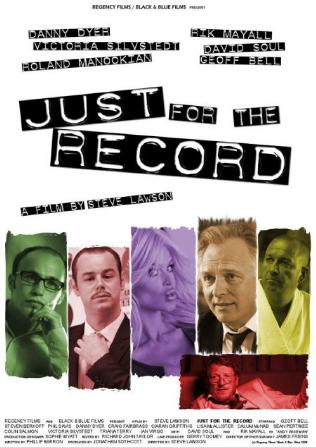 In recent years I have watched and reviewed two recursive mockumentaries; that is, spoof documentary films about the making of fictitious narrative films. There was Mark Withers’
In recent years I have watched and reviewed two recursive mockumentaries; that is, spoof documentary films about the making of fictitious narrative films. There was Mark Withers’ 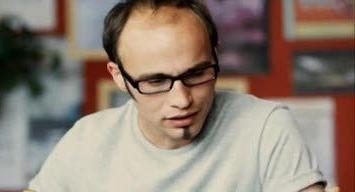 Noble is an arrogant prick who believes that he is making an ‘experience’. He hands out ashtrays instead of business cards (which could have been funny if handled right, but isn’t) and wears personalised underpants (which was never going to be funny). Allgen takes on the position of First AD, thereby making him another self-important little tosser, and when not on set he is completely gay for Noble (which again, could have been funny but isn’t). I’m going to need a shorthand for that, aren’t I? I’ll use ‘ashtray’, okay? From now on, anything which I describe as ‘ashtray’ or ‘an ashtray’ is something which, in a good script and with a bit of directorial care and a half-decent actor, could actually have been funny. But here, for whatever reason, it ain’t.
Noble is an arrogant prick who believes that he is making an ‘experience’. He hands out ashtrays instead of business cards (which could have been funny if handled right, but isn’t) and wears personalised underpants (which was never going to be funny). Allgen takes on the position of First AD, thereby making him another self-important little tosser, and when not on set he is completely gay for Noble (which again, could have been funny but isn’t). I’m going to need a shorthand for that, aren’t I? I’ll use ‘ashtray’, okay? From now on, anything which I describe as ‘ashtray’ or ‘an ashtray’ is something which, in a good script and with a bit of directorial care and a half-decent actor, could actually have been funny. But here, for whatever reason, it ain’t.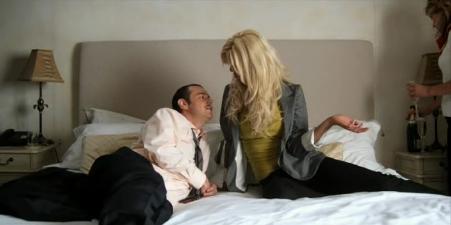 Dyer’s characterisation of La Farge is comedic but believable - in stark contrast to the unsubtle, unfunny wannabe-wackiness of Manookian, Griffiths and Virgo. It’s like he’s in a sitcom and they’re all in a sketch show. And not a good sketch show either; one of those sketch shows on BBC3 that makes your brain hurt as you try to work out how and why it was ever commissioned.
Dyer’s characterisation of La Farge is comedic but believable - in stark contrast to the unsubtle, unfunny wannabe-wackiness of Manookian, Griffiths and Virgo. It’s like he’s in a sitcom and they’re all in a sketch show. And not a good sketch show either; one of those sketch shows on BBC3 that makes your brain hurt as you try to work out how and why it was ever commissioned.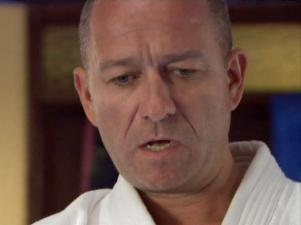 Pertwee (
Pertwee ( What a bunch of deeply unsympathetic characters we’ve got here. Some are horrible, some are stupid, some are horrible and stupid, some are simply bland. Which raises the question: what makes a sympathetic film character? Well, in a thriller, horror film or action movie, a sympathetic character is one who you want to, if not win, at least survive until the end of the film. That’s one of the reasons why I hated
What a bunch of deeply unsympathetic characters we’ve got here. Some are horrible, some are stupid, some are horrible and stupid, some are simply bland. Which raises the question: what makes a sympathetic film character? Well, in a thriller, horror film or action movie, a sympathetic character is one who you want to, if not win, at least survive until the end of the film. That’s one of the reasons why I hated  The fake film is also called
The fake film is also called 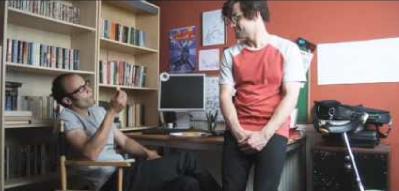 So why did Steven Lawson decide to shoot it all - interviews and fake behind-the-scenes stuff - like a conventional narrative film? We expect talking-head interviews to be done in one take, with maybe some cutaways to the interviewer nodding to cover unavoidable edits. That’s how documentaries look. Everyone knows that. We’ve all seen enough. We don’t expect multiple takes of the same interview from different angles to be edited together like a real feature film because that completely destroys what little illusion there may have been that these are real people talking about a real film.
So why did Steven Lawson decide to shoot it all - interviews and fake behind-the-scenes stuff - like a conventional narrative film? We expect talking-head interviews to be done in one take, with maybe some cutaways to the interviewer nodding to cover unavoidable edits. That’s how documentaries look. Everyone knows that. We’ve all seen enough. We don’t expect multiple takes of the same interview from different angles to be edited together like a real feature film because that completely destroys what little illusion there may have been that these are real people talking about a real film.